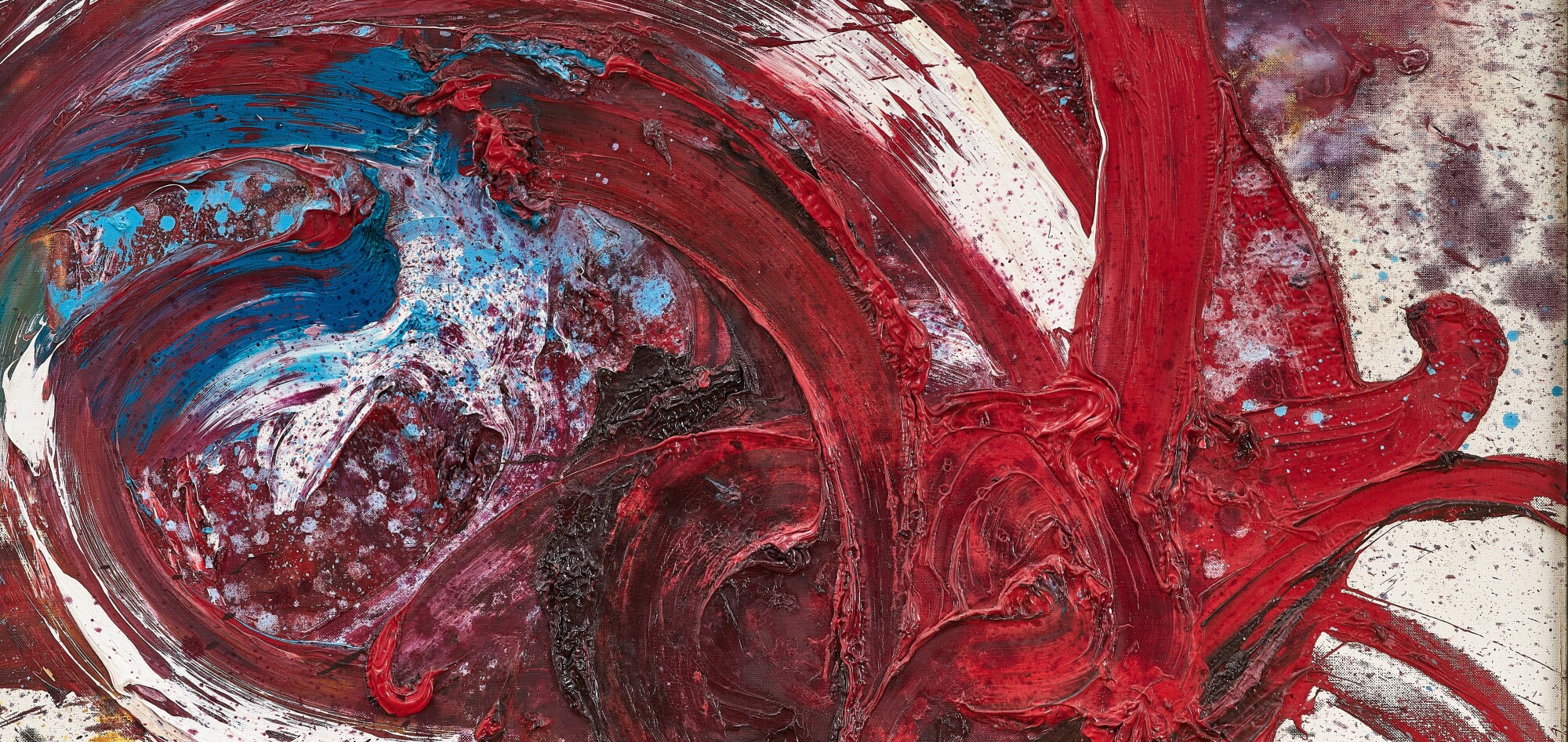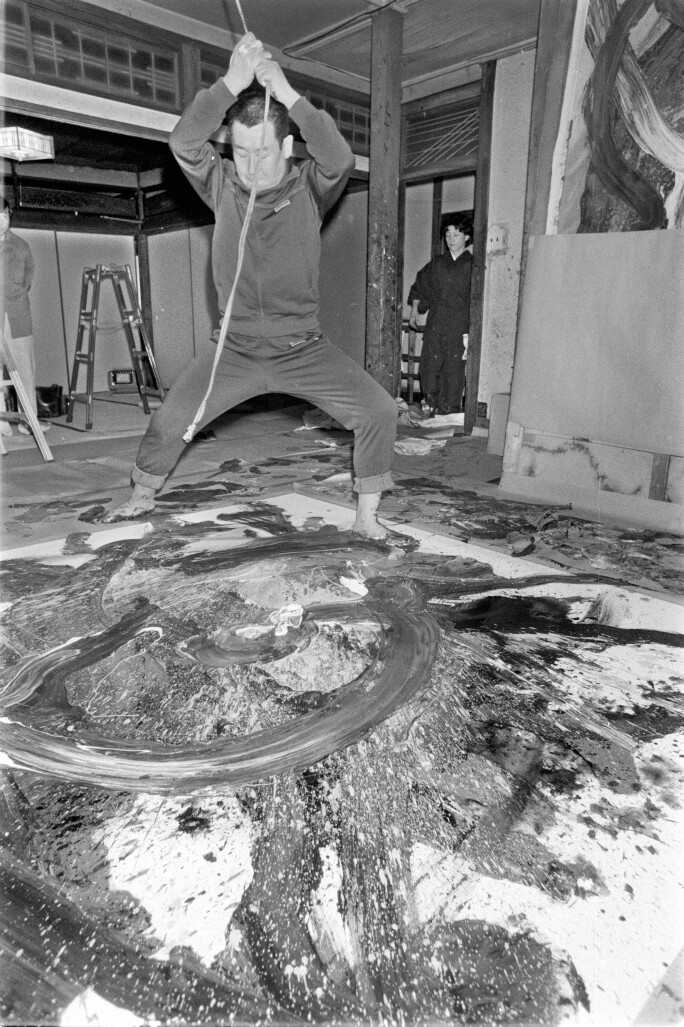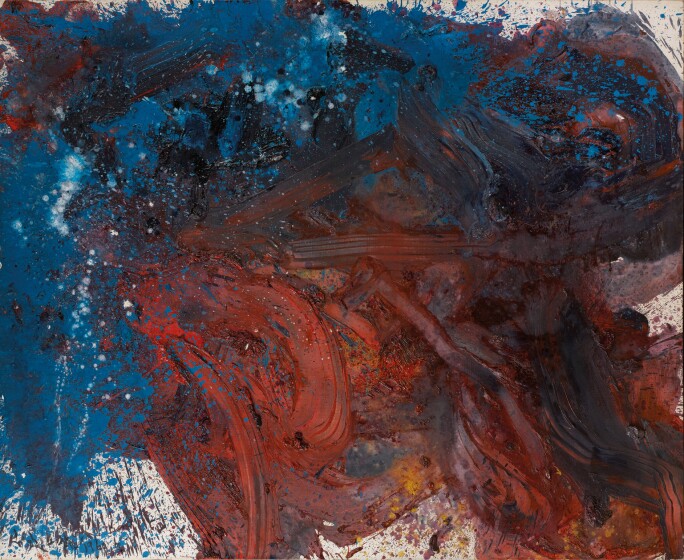F
erocious, provocatively primal, yet charged with exhilarating grace, Shiraga Kazuo’s BB85 is an exceptional work from the artist’s critical early period, regarded for its explosive dynamism and iconic colour palette. Produced in 1961, the present work coincides with Kazuo’s groundbreaking inaugural solo exhibition outside Japan at Galerie Stadler in Paris in 1962, with some of the artist’s most identifiable and celebrated pieces being made in this early part of his illustrious career. Writhing with fiery vigour and potent visceral violence, the present work is marked by Kazuo’s favourite vivid burgundy shade called ‘Crimson Lake’ punctuated by a whirl of electric cerulean blue and splashes of inky black running throughout the composition. Whilst smaller canvases (like the present work) from this period are exceedingly rare, BB85 is a prime example of Kazuo wider oeuvre defined by its impassioned expression of paint and movement.

SOTHEBY’S PARIS, 21 OCTOBER 2020, SOLD FOR US$3,031,344 ©Estate of Kazuo Shiraga
白髮一雄,《地會星神算子》,1961年作,油彩畫布,巴黎蘇富比,2020年10月21日,成交價:3,031,344 美元 ©Estate of Kazuo Shiraga
Born in 1924 in Amagasaki, Hyogo Prefecture to the family of a kimono business owner, Shiraga was exposed to traditional Japanese art from a young age: calligraphy and antiques, classical theatre and cinema, ukiyo-e prints and ancient Chinese literature. After studying traditional Japanese painting in Kyoto, Shiraga began to move away from the figurative style and pursue a more emotional direction of art, which, in the early 1950s, was marked by a desire to challenge artistic forms. Shiraga’s artistic legacy is rooted in this aspirational post-war period, with Shigara becoming a renowned representative of Gutai, one of the most highly acclaimed of the new art movements of the time. Informed by the memory of war time violence, Gutai aimed at the creation of innovative art. Founded in 1954 by Jiro Yoshihara, many of the group’s acolytes went on to great renown, including Saburo Murakami, Sadamasa Motonaga and, of course, Shiraga, who embraced this radical form of artistic practise.


As the defining element of Japanese post-war culture and with a strong focus on happening, performance and conceptual art, Gutai encouraged Shiraga to develop a unique technique of pouring paint on the canvas and creating brushstrokes with his feet by swinging on a rope hung from the ceiling. Shiraga’s performative abstractions are vehemently inspirited with movement, “not just the movement of his body […] but also the assertion of matter itself” (Ming Tiampo, “Not just beauty, but something horrible”, in Exh. Cat. Body and Matter: The Art of Kazuo Shiraga and Satoru Hoshino, New York 2015, pp. 21-22). Gutai’s legendary practise, whilst incorporating elements such as action painting that were familiar in the West owing to the work of Jackson Pollock and Willem de Kooning, anticipated future art movements in their emphasis on concept and performance, with Shiraga emerging as a leading voice of his generation.

SOTHEBY'S HONG KONG, 9 JULY 2020, SOLD FOR US$3,428,988 © Estate of Kazuo Shiraga
白髮一雄,《地退星翻江蜃》,1960年作,油彩畫布,香港蘇富比,2020年7月9日,成交價:3,428,988 美元 © Estate of Kazuo Shiraga
BB85 writhes with the primal tactility and visceral potency that has come to define Shiraga’s oeuvre, his legendary feet-generated strokes trashing across the canvas in an expression of impassioned urgency. The relationship between body and paint, performance and art is undeniable in this present work, which demonstrates the totality of the artist’s practise: “I first used a palette knife, then a piece of wood, then my bare hands, and then my bare feet. In order to place a massive amount of paint on canvas all at once, I had to remove the canvas from the wood frame and affix it directly to the floor. Should I have used a conventional upright canvas placed on easel the mass of paint would have created something like a flood-induced landslide or an avalanche on winter mountains. In order to prevent myself from slipping on the paint, I needed to have a piece of rope from the ceiling so that I could hold onto it. Thus began my foot painting, or painting with feet by sliding over canvas” (Shiraga Kazuo cited in: Reiko Tomii and Fergus McCaffrey, Kazuo Shiraga: Six Decades, New York 2009, p. 68). Rendered in swathed of radiant blue and deep red, the present work embodies the vigour with which Shiraga engaged in a critical discourse on violence, destruction and post-war Japan’s trauma. Almost sculptural in its depth, the passages of deep carmine attest to the dynamic process of his painting, the convulsions across the canvas tracing the movements of the artist’s body. It is Shiraga’s unique gesture and motion which gives his work its momentous immediacy and has made him one of the definitive artistic voices of the 20th century.